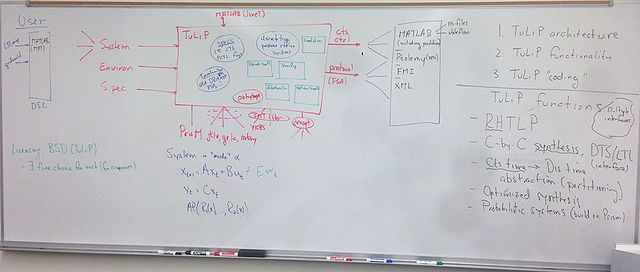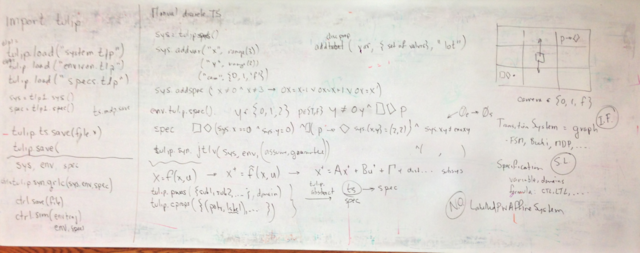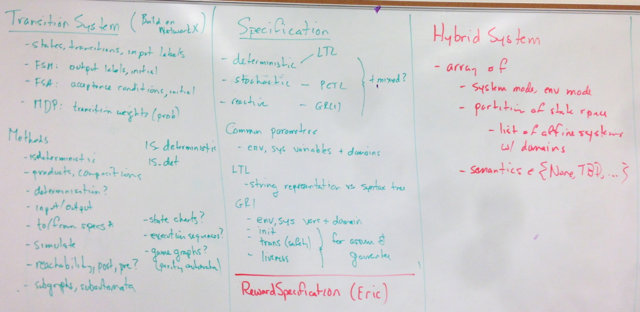|
|
| Line 9: |
Line 9: |
| == Examples == | | == Examples == |
| This section contains a set of example that illustrate how the TuLiP code should be structured. This goes first so that we focus on the TuLiP interface and functionality and then figure out what is required to support it. | | This section contains a set of example that illustrate how the TuLiP code should be structured. This goes first so that we focus on the TuLiP interface and functionality and then figure out what is required to support it. |
|
| |
| === Load up an example stored in files and synthesize a controller ===
| |
| This example shows how to load up a problem that is specified in files and synthesize a controller. Save the controller to a file, but also generate a version that can be executed in Ptolemy.
| |
|
| |
| ==== Code ====
| |
| <pre>
| |
| import tulip
| |
|
| |
| # Load up the system and environment descriptions, plus specifications
| |
| system = tulip.ts.load("robot-discrete.tsf")
| |
| environment = tulip.sp.load("robot-env.spf")
| |
| specs = tulip.sp.load("robot-specs.spf")
| |
|
| |
| # Synthesize a controller
| |
| controller = tulip.syn.jtlv(system, environment, specs)
| |
|
| |
| # Save the controller in TuLiP and Ptolemy formats
| |
| tulip.ts.save("robot-control.tsf")
| |
| tulip.ptolemy.savefsm("robot-control.fsm")
| |
| </pre>
| |
|
| |
| ==== Notes ====
| |
| # The <tt>.tsf</tt> (transition system file) and <tt>.spf</tt> (specification file) formats are the default TuLiP file formats.
| |
| #* Alternatively, perhaps we have a single file format <tt>.tlp</tt> and then use <tt>tulip.load</tt> and <tt>tulip.save</tt> to read and write. The type of object would just be part of the file specification. --[[User:Murray|Richard Murray]] ([[User talk:Murray|talk]]) 15:07, 11 May 2013 (PDT)
| |
| # The <tt>ts</tt> module contains data types and functions for representing different types of transition systems. Multiple transition systems are supported, including deterministic transition systems, Markov decision processes, Kripke structures, Rabin automata, etc.
| |
| # The <tt>sp</tt> module contains data types and functions for representing specifications. Multiple temporal logics, including LTL, MTL, CTL, PCTL, TCTL, STL, etc are supported.
| |
| # The <tt>syn</tt> module contains interfaces to various synthesis tools. Supported tools include JTLV, gr1c and PRISM. The input arguments must be compatible with the synthesis tool, but all arguments should be core TuLiP objects.
| |
| #* Would it make more sense to have a module for each program we support? So this line would become <tt>tulip.jtlv.syn</tt>? --[[User:Murray|Richard Murray]] ([[User talk:Murray|talk]]) 15:07, 11 May 2013 (PDT)
| |
| # The <tt>ptolemy</tt> module contains functions for interfacing with Ptolemy.
| |
| #* Should we instead make an FMI interface and then use Ptolemy's FMI capability? --[[User:Murray|Richard Murray]] ([[User talk:Murray|talk]]) 15:09, 11 May 2013 (PDT)
| |
| #* We should be careful about MoC the automaton is synthesized for (event-based, discrete-time, continuous-time etc.) while interfacing. Ptolemy and FMI seem to have better support for certain types. -- Necmiye
| |
| # It would be nice to have transition system class support symbolic representations (e.g., based on variable tuples as is now instead of listing all states). For instance for a 10x10 grid, one might want to define the problem in terms of x and y coordinates instead of listing 100 states. Another example where listing the states is difficult is vms examples, where we have temperature, ice_level, wind_level, etc. This way we can take better advantage of underlying symbolic computations. -- Necmiye
| |
| #* The <code>gridworld</code> module already provides an example of this. --[[User:Slivings|Slivings]] ([[User talk:Slivings|talk]]) 09:09, 14 May 2013 (PDT)
| |
|
| |
| === Create a discrete example from scratch ===
| |
|
| |
| This example shows how to create a system and environment from scratch, then synthesize a controller. It is based on the <tt>robot-simple.py</tt> example that is distributed with TuLiP and used in the EECI short course.
| |
|
| |
| ==== Code ====
| |
| <pre>
| |
| import tulip
| |
|
| |
| #
| |
| # Create the system transition system corresponding to a 2x3 grid of cells
| |
| #
| |
| system = tulip.ts()
| |
| system.addstates({'c11', 'c12', 'c13', 'c21', 'c22', 'c23'})
| |
|
| |
| # Allow transitions between adjacent cells
| |
| system.addtransition('c11', True, {'c12', 'c21'})
| |
| system.addtransition('c12', True, {'c11', 'c13', 'c22'})
| |
| system.addtransition('c13', True, {'c12', 'c31'}})
| |
| system.addtransition('c21', True, {'c12', 'c22'})
| |
| system.addtransition('c22', True, {'c21', 'c23', 'c12'})
| |
| system.addtransition('c23', True, {'c22', 'c13'}})
| |
|
| |
| # Add labels to selected points
| |
| system.addlabel('home', 'c11')
| |
| system.addlabel('lot', 'c13 or c23')
| |
|
| |
| #
| |
| # Create an environment that allows an obstacle to move around in the same state space
| |
| #
| |
| # We model the environment in a slightly different way, just to show functionality
| |
| #
| |
| environment = tulip.ts()
| |
|
| |
| environment.addvar('obs', system.states)
| |
| envspec = tulip.spec(environment,
| |
| ( obs = c11 -> next (obs = c12 or obs = c21) ) and
| |
| ( obs = c12 -> next (obs = c11 or obs = c13 or obs = c22) ) and
| |
| ( obs = c13 -> next (obs = c12 or obs = c31) ) and
| |
| ( obs = c21 -> next (obs = c22 or obs = c12) ) and
| |
| ( obs = c22 -> next (obs = c21 or obs = c23 or obs = c12) ) and
| |
| ( obs = c23 -> next (obs = c22 or obs = c13) )
| |
| ')
| |
|
| |
| environment.addvar('park', {1, 0})
| |
| envspec = envspec + tulip.spec(environment, '[] <> !park')
| |
|
| |
| #
| |
| # System specification
| |
| #
| |
| spec = tulip.spec({system,environment}, envspec + '->
| |
| (always eventually home) and
| |
| (always (park -> eventually lot)) and
| |
| (always !(
| |
| (obs = c11 and c11) or
| |
| (obs = c12 and c12) or
| |
| (obs = c13 and c13) or
| |
| (obs = c21 and c21) or
| |
| (obs = c22 and c22) or
| |
| (obs = c23 and c23) ) )
| |
| ')
| |
|
| |
| # Synthesize the automaton
| |
| controller = tulip.syn.jtlv(system, environment, spec)
| |
|
| |
| # Simulate the system
| |
| </pre>
| |
|
| |
| === Discretize continuous dynamics ===
| |
| <pre>
| |
| import tulip
| |
| import control
| |
|
| |
| # Create a hybrid system with 2D continuous space and no discrete dynamics
| |
| system = tulip.hybrid(2, {})
| |
|
| |
| # Define the dynamics for the system
| |
| sysdyn = control.ss({{0,0,1,0}, {0,0,0,1}, {0, 0, 0, 0}, {0,0,0,0}}, {{0,0}, {0,0}, {1,0}, {0,1}}, {{1,0,0,0}, {0,1, 0,0}}, 0)
| |
|
| |
| # Define the regions for the system, along with labels and dynamics
| |
| system.addregion({{0,0}, {1,1}}, 'c11', sysdyn)
| |
| system.addregion({{1,0}, {2,1}}, 'c12', sysdyn)
| |
| system.addregion({{2,0}, {3,1}}, 'c13', sysdyn)
| |
| system.addregion({{0,1}, {1,2}}, 'c21', sysdyn)
| |
| system.addregion({{1,1}, {2,2}}, 'c22', sysdyn)
| |
| system.addregion({{2,1}, {3,2}}, 'c23', sysdyn)
| |
|
| |
| # Discretize the dynamics
| |
| tulip.discretize(system, 0.01)
| |
| </pre>
| |
|
| |
|
| Notes from 14 May meeting: | | Notes from 14 May meeting: |


